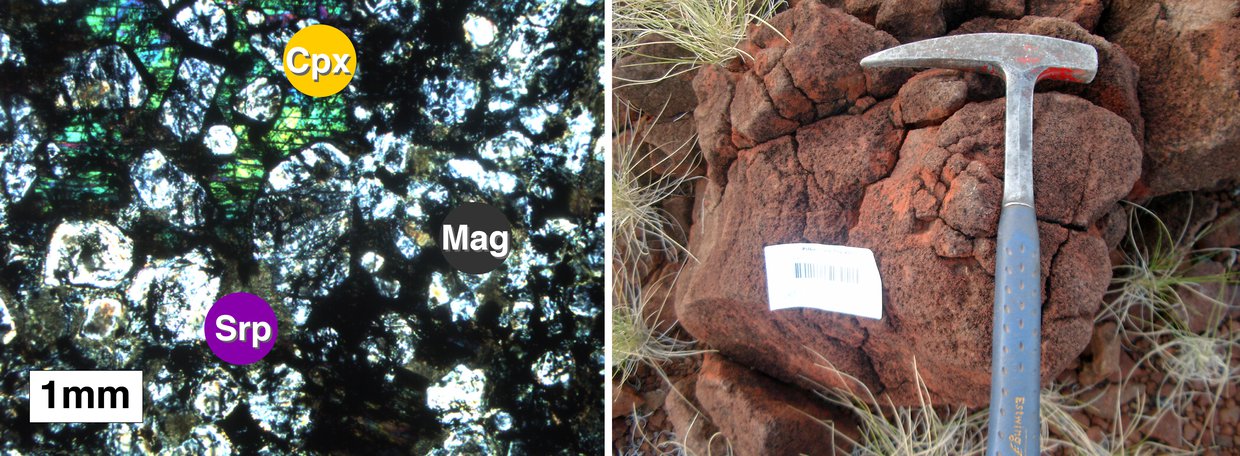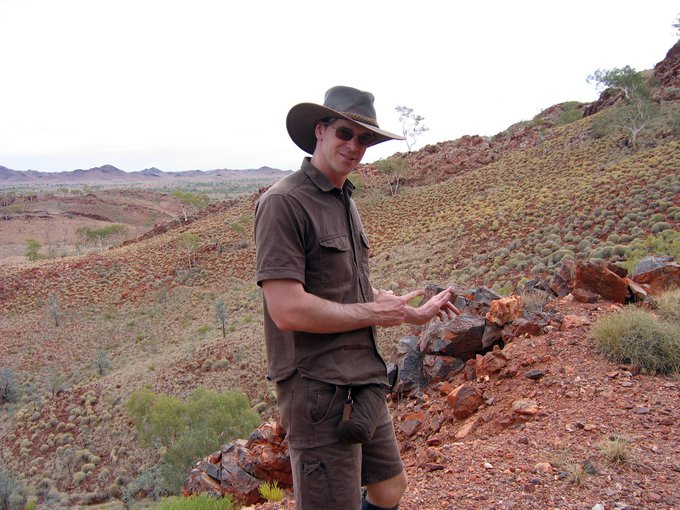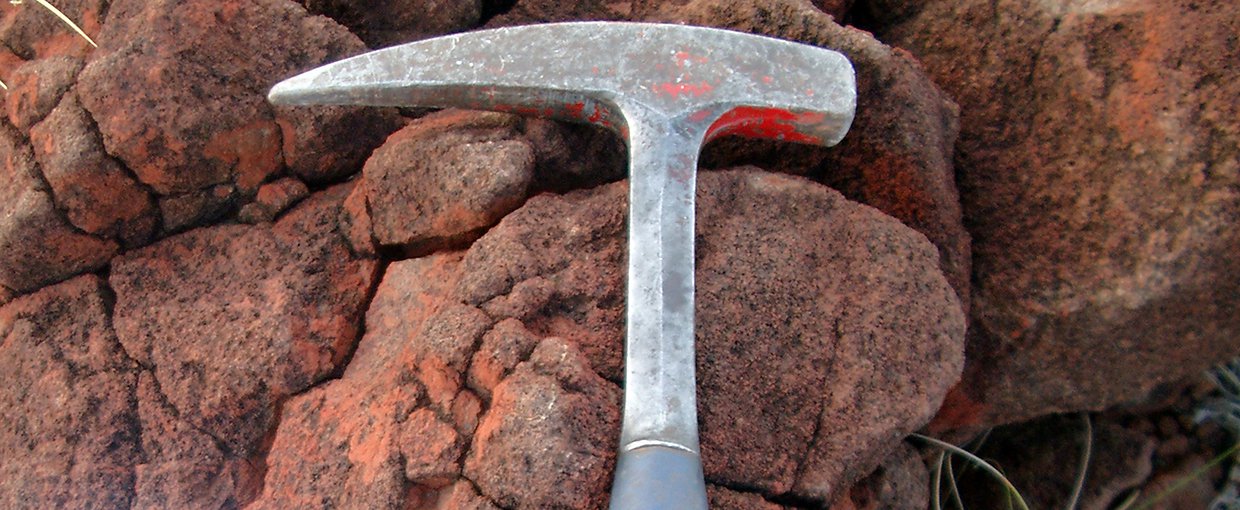
Researchers supported in part by the NASA Astrobiology Program have provided new insight into the history of minerals in the region of Mars’ Jezero crater, the landing site of NASA’s upcoming Mars 2020 mission. The research team used remote sensing data from an instrument aboard NASA’s Mars Reconnaissance Orbiter (MRO) to identify correlations between olivine and carbonate in the area that will soon be home to the Perseverance rover.
Jezero crater is located in a region of Mars known as Nili Fossae, and was selected as a landing site because it is contains features that are thought to have been shaped by liquid water in Mars’ ancient past. For instance, Jezero has well-preserved delta deposits that were washed into the crater from the surrounding area. This water likely filled a lake within Jezero until the end of Mars’ Noachian age.

Location of Nili Fossae and Jezero crater. The base map obtained using JMars (Christensen et al., 2009). Red box marks the region of interest in Brown et al. 2020. Pale green indicates the olivine‐carbonate unit mapped by Kremer et al. (2019).Image credit: Courtesy of the authors (Brown et al., 2020).
Data from MRO’s Compact Reconnaissance Imaging Spectrometer for Mars (CRISM) instrument was used to examine how carbonate minerals were emplaced at the Jezero site. CRISM was designed to identify minerals on Mars that formed in the presence of water by looking at light reflected from the martian surface. The instrument detects patterns that act as signatures for mineral deposits that were formed through long-term interactions between water and rock. MRO data has shown that carbonates in this area are associated with olivine, and it was the processes behind this co-occurrence of minerals that attracted the attention of the research team.
Olivine refers to a group of minerals that are associated with volcanic activity. Olivine is a silicate containing varying amounts of magnesium (Mg) and iron (Fe). Carbonates refer to minerals that contain a carbonate ion (CO32-), and are of interest to astrobiology because they are typically formed through the interaction of carbon dioxide and liquid water. This makes carbonate deposits excellent targets of study for astrobiologists who are trying to determine aspects of Mars’ ancient environment.
“When we first mapped the carbonates in 2008 using CRISM, we found that they ALWAYS occurred with an accompanying olivine 1 micron band,” explains lead author Adrian Brown, Deputy Program Scientist on Mars 2020.

Serpentinized talc-carbonate komatiite rock from the Mount Ada Basalt in Australia's Pilbara region (hammer is for scale).Image credit: Adrian Brown.
Brown has been studying a process known as hydrothermal serpentinization which, in the presence of olivine, produces carbonates as a byproduct of the reaction. In their work, they examined how hydrothermal serpentinization in Earth’s past impacted Archean rocks found in Australia’s Pilbara region. In a paper in 2010, Brown and colleagues outlined spectral similarities between the Pilbara rocks (roughly 3.48 billion years old) and materials in Jezero (roughly 3.81 billion years old). The rocks from the Pilbara show a similar thermal inertia (resistance to abrasion or friability) to those seen on Mars, and are stratigraphically just beneath the stromatolite-bearing 3.48 billion year old Strelley Pool Chert.
“The serpentinization reaction takes carbon dioxide from a water fluid and, in the presence of olivine, will create serpentine or talc (replacing some of the olivine) and form carbonates,” said Brown. “This process in Archean rocks is quite common, and they call it talc-carbonation.”
Talc mines on Earth rely on the byproducts of this reaction, but the process can also take place around undersea vents that provide energy for thriving ecosystems on the ocean floor. Carbonates are not produced from olivine directly, but they are the result of hydrothermal serpentinization that requires small amounts of carbon dioxide and liquid water flowing through the rock. So far, Brown and his team believe that serpentinization appears to be the leading explanation for the observed association between olivine and carbonate in Mars’ Jezero crater, and could indicate that this area once supported conditions habitable for life as we know it.

Thin section (left) in transmitted light of serpentinized komatiite rock (right) from the Mount Ada Basalt in Australia's Pilbara region (hammer shown for scale). Labels: Serpentine replacing olivine (SRP); clinopyroxene (CPX; Magnetite (MAG).Image credit: Adrian Brown.
Carbonate Origins
When robotic exploration of Mars began, many scientists expected to see large sedimentary deposits of carbonate on Mars. Evidence points to liquid water on the surface of ancient Mars, but questions remain as to how the planet was warm enough for this water to persist. It has been suggested that the planet’s carbon dioxide-rich atmosphere must have been thick enough at the time to create a global greenhouse. Climate models based on the idea of a thick CO2 atmosphere have shown that if this scenario were true, weathering on Mars would have created large carbonate deposits on the surface over time. However, observations from numerous spacecraft have yet to identify deposits consistent with these predictions.
The largest carbonate deposit found thus far is in Nili Fossae, and this is one reason the site was selected for Mars 2020. Sampling efforts in the region could help solve the question of where the carbonates came from. Were they formed through serpentinization? Or are they left over from interactions between rocks and Mars’ atmosphere? A 2020 paper by Briony Horgan and colleagues even suggests that the carbonates could be the remains of stromatolites around the edge of the crater.
These are questions that the Perseverance rover will not directly answer when the rover touches down in Jezero crater, but the mission is the first step in further lines of study. Among its scientific objectives, Perseverance will use its drill to collect samples of Martian rock and soil in a process referred to as ‘sample caching.’ The idea is that the rover will store samples that could be returned to Earth at a later date by a Mars Sample Return mission. If the sample return effort is successful, scientists on Earth would then be able to study pristine pieces of the red planet with instruments and methods that are currently too large or complicated to be performed robotically on Mars.

Illustration of NASA's Perseverance rover on Mars.Image credit: NASA.
Population Zero
The new findings provide step forward in constraining the mechanisms that could have led to the current composition of Mars’ surface in Jezero crater and set the stage for further work. The study employed a new approach for mapping the Mg and Fe composition of martian olivine from orbit. The work was based on previous studies of olivine on the Moon, as well as laboratory work on synthetic olivine samples. Using their method, the team was able to quantify the amount of Fe versus Mg that composes olivine at Mars’ surface. The paper is an initial attempt, and the team acknowledges that the methods must be refined further, yet they were able to glean important insights from these initial mapping efforts. What they found were a range of olivine signatures that showed varying levels of saturation. Interestingly, the most saturated olivine signatures had no correlation with carbonates at all, and could represent locations on Mars where olivine has not been altered by serpentinization.
“The process of serpentinization is the best way to explain why the carbonate only occurs with the olivine,” said Brown, “but the new 2020 paper shows that the vice versa condition doesn’t hold.”
In the data from MRO, the team identified these areas of pristine olivine that were absent of carbonate. Last summer, at the 9th International Conference on Mars, the team of researchers presented the findings, referring to the cache of pristine olivine as ‘population zero’ because it likely represents olivine that has not undergone serpentinization.
“If we can understand more about the population zero olivine, we can learn more about the processes that may have led to the carbonate,” said Brown.

Adrian Brown in Australia's Pilbara standing in front of hydrothermal black chert dykes.Image credit: Geoffrey Bruce.
In a sense, the olivine deposits that the team identified provide a starting point for analyzing data that will be gathered by Perseverance in the coming years. The team believes that the olivine deposits they have identified are a precursor to the carbonated and hydrated olivine that Perseverance will be directly inspecting at its landing site. Understanding how those minerals started out could be critical in determining the environmental conditions that led Jezero crater to look like it does today, and whether or not there was a point in history where the crater and the lake it held could have been habitable for life.
“Another reason it’s important to recognize the population zero olivines is that we can look for them in Jezero crater,” said Brown. “With CRISM, we have detected them north of the crater, but because of the mixing with carbonates and other stuff at Jezero, we can’t be sure that the olivine is say 50% ‘population zero’ or whether just some grains may occur in loose boulders that we visit. But we’ll be looking for it.”
Mission Background
MRO launched in 2005, and has since been making observations that help scientists interpret the history of liquid water on Mars. Many Mars missions have provided evidence that liquid water once flowed on the surface of the red planet, but MRO provides data that can help us understand just how long this water persisted.
The Perseverance rover is a key component of NASA’s Mars 2020 mission, which is scheduled to launch this summer from Cape Canaveral. Mars 2020 is the next step in NASA’s long-term robotic exploration of the red planet. The Perseverance rover expands upon the framework developed for NASA’s Curiosity rover, and is designed to addressed key questions about the potential for life on ancient Mars.

Jezero Crater contains the fossil remains of a river delta and is where the Mars 2020 rover will land. The image, taken by NASA’s Mars Reconnaissance Orbiter (MRO), uses non-Martian colors to highlight specific features and mineral deposits.Image credit: NASA/JPL-Caltech/ASU.
The study, “Olivine‐Carbonate Mineralogy of the Jezero Crater Region,” was published in the Journal of Geophysical Research: Planets. The work was supported in part through the NASA Astrobiology Institute (NAI) element of the NASA Astrobiology Program. The NAIconcluded activities at the end of 2019. This research is a critical part of NASA’s work to understand the Universe, advance human exploration, and inspire the next generation. As NASA’s Artemis program moves forward with human exploration of the Moon, the search for life on other worlds remains a top priority for the agency.


